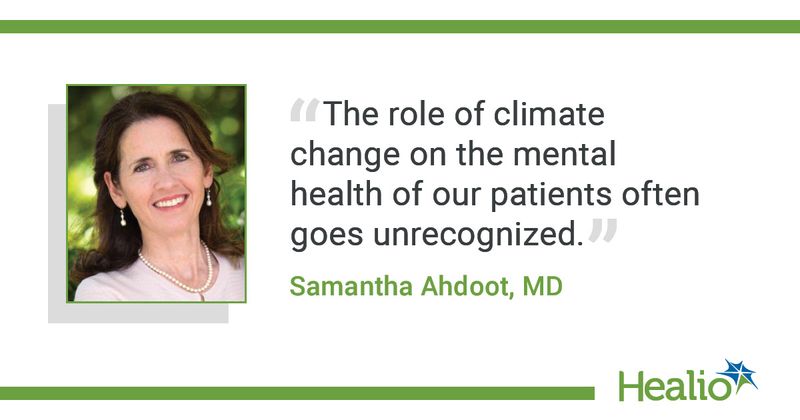Q&A: AAP warns about climate change’s impact on child health
Key takeaways:
- Climate change affects children through harmful air and water quality and changing patterns of infectious diseases.
- The mental health effects of climate change often go unnoticed.
An updated AAP policy statement outlines the impact of climate change on children’s health and offers related recommendations for the medical and government sectors.
Nearly 10 years after the AAP last published a policy statement on the dangers of climate change, the AAP’s Council on Environmental Health and Climate Change and Council on Children and Disasters recommended that policymakers promote energy efficiency and renewable energy production at the federal, state and local levels, and preserve essential public health protections in the Clean Air Act.

The updated policy statement and a related technical report also advised that governments expand public transportation, increase construction of safe bikeways and walkways and support urban planning designs that reduce dependence on automobile transit, as well as provide funding as an incentive to reduce reliance on livestock as food and promote plant-based diets.
We spoke with co-author Samantha Ahdoot, MD, assistant professor of medical education at the University of Virginia School of Medicine, about the policy statement and what pediatricians can do.
Healio: Why did the committee decide to update the policy statement?
Ahdoot: The AAP was the first U.S. medical society to publish a report on the changing climate and the health of people in 2007. This was a pivotal step because it acknowledged that physicians must care for the planet to care for our patients. Research on this topic has increased dramatically since that time, requiring updates to the original report in 2015 and now in 2024.
Healio: How does climate change threaten children’s physical health?
Ahdoot: The Earth is undergoing major shifts in temperature, rainfall and extreme weather patterns as a result of heat-trapping pollution from our burning of fossil fuels. This is harming air and water quality, changing patterns of some infectious diseases and resulting in more devastating wildfires and storms, among many other changes that inevitably affect the health of people.
These changes are particularly harmful for children for several reasons. First, their bodies are still growing, and harmful exposures can interrupt healthy development with potentially life-long effects. Children are more active outside, so they have greater exposure to heat and contaminants, and they are dependent on their caregivers for their health and safety.
Healio: How does it threaten their mental health?
Ahdoot: As pediatricians assume greater responsibility for care of youth mental health challenges, there is a need to incorporate the role of environmental harm. Pediatricians in the U.S. are already caring for children whose mental health is affected by climate change. A Lancet Planetary Health study found that more than three in four surveyed American children feel that people have failed to care for the planet. Approximately one in three feel that the government is failing young people and are frightened of the future.
Young people are affected by climate change through diverse pathways that can be direct and immediate, through extreme weather events; indirect and gradual, through environmental harm and loss of treasured places; or vicarious, through overarching awareness of the problem. But the role of climate change on the mental health of our patients often goes unrecognized. For example, pediatricians caring for children affected by extreme weather events may see events as isolated emergencies rather than connected to the broader problem of climate change.
Healio: How can pediatricians influence climate policy to protect their patients?
Ahdoot: As a thought leader in this space since 2007, the AAP has nurtured a strong foundation for pediatrician climate advocacy. The AAP was a founding member of the national Medical Society Consortium on Climate and Health, launched in 2016. Their executive director, the amazing Lisa Patel, MD, MESc, is a pediatrician and fellow of the AAP. Pediatricians are leading local, state and national climate change advocacy campaigns aimed at reducing fossil fuel pollution in their health care systems, states, and nationally.
Pediatricians across the country can work with their state AAP chapter or groups like the one I chair, Virginia Clinicians for Climate Action, to advance climate solutions. We can help increase clean energy sources like solar and wind; create greater access to vegetables and grains and diets with less highly processed meats and sugars; build safe, shaded routes for families to walk and bike; and increase access to public transportation. We can ensure engagement with communities at highest risk as a result of historical underinvestment and racist policies. And we can partner with young people in this process. Let kids know that they can be powerful agents of change.
I also want to share another action opportunity — write a book! The book The Air They Breathe by pediatrician Debra Hendrickson, MD, is coming out this summer. It is a remarkably powerful and beautiful portrayal of children across the country whose lives are changing due to the changing climate.
References:
Ahdoot S, et al. Pediatrics. 2024;doi:10.1542/peds.2023-065504.
Ahdoot S, et al. Pediatrics. 2024;doi:10.1542/peds.2023-065505.
Hickman C, et al. Lancet Planet Health. 2021;doi:10.1016/S2542-5196(21)00278-3.

